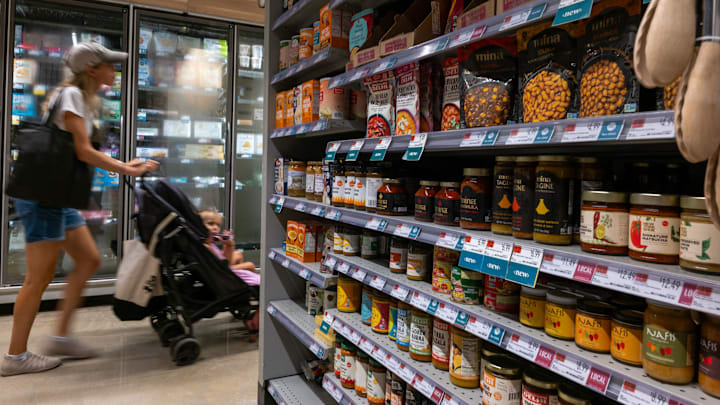Rising inflation is impacting grocery prices across the board, making it increasingly difficult to stick to a budget. As food prices continue to soar, it’s become increasingly important to manage your grocery bill. These tips will guide you on how to stop overspending on food without sacrificing quality or nutrition.
1. Make a shopping list and stick to it
A shopping list is one of the simplest yet most effective strategies to avoid overspending. Several studies tell us that shoppers who use a list spend less than those who don’t because they keep you focused, minimizing impulse buying.
Plan your meals for the week and check your pantry and refrigerator before creating the list so you know what you need. Categorize items depending on their location in the store to help you move efficiently through the aisles, reducing the temptation to wander into sections filled with non-essential, high-cost items.
The best shopping list is detailed, specifying items and quantities. If you’re not the traditional pen-and-paper type, you can use grocery apps to organize your list digitally. Just ensure you have it handy when you shop and resist the temptation to deviate from your list.
2. Shop the perimeter of the store
Grocery stores are designed to encourage spending by playing on your psychology. The most expensive and tempting items are often placed at eye level or in the front aisles, where you’ll likely make impulsive purchases. Along the perimeter is where you’ll typically find fresh produce, dairy, meat and other essentials. Shopping the perimeter helps you stick to your budget and promotes a healthy diet.
3. Buy in bulk — But be smart about it
Procuring large quantities of non-perishable products can lead to substantial savings over time. This goes for items like grains, pasta, canned and frozen foods. However, you must be strategic about your purchases, as bulk buying is only beneficial if you use the goods before expiration. Consider your consumption rate to minimize overspending and reduce food waste.
4. Prioritize locally sourced produce
Locally sourced products, mainly fruits and vegetables, are often more affordable than those shipped from other regions. Prices drop further when they’re in season. Most farm produce begins to lose nutrients three days post-harvest, and since local crops don’t have to travel long distances, these products are fresher and tend to have a longer shelf life. Less spoilage and waste translates to fewer trips to the store.
What’s more, buying local supports your community’s economy. You create demand for these products, promoting farmers’ enterprises. Farmers supply their wares to supermarkets at lower prices thanks to the ready market. Customers then get good deals on these items, reducing how much they spend on groceries.
5. Avoid shopping when hungry
Going shopping while hungry is a surefire way to overspend. Everything looks good, and you’re likely to grab items you don’t need.
If you haven’t heard of the “grocerant,” it’s where a grocery mart has a mini-restaurant inside. This form of in-store food service is very convenient, but with 63% of consumers reporting high food prices at eateries, you might want to steer clear of the grocerant. Fresh produce and meats are seeing the highest increases, and it is this surge that is making restaurants hike their menu prices. And while you might be tempted to buy from the deli section, remember they’re also experiencing inflation and their ready-to-eat dishes are sure to reflect this.
To avoid this pitfall, eat or have a snack before you shop to alleviate cravings. This will help you maintain focus, making it easier to resist buying unnecessary treats.
6. Use coupons and loyalty programs
The price of groceries has increased by over 11% in just a year. This rising inflation continues to impact consumer behavior, and it’s now common to hear about food crimes. Consumers are also turning to loyalty programs and coupons to stretch their grocery budgets.
Take advantage of this trend and start collecting coupons. Gone are the days when people cluttered their purses and wallets with paper coupons. Many stores offer shoppers digital versions they can load onto their loyalty cards. Collect these and consider stacking them for maximum savings.
If you can sign up for a rewards program, do it! These programs offer special discounts and cash-back tokens. Most grocery stores have a points-based system that allows you to redeem points for future purchases.
7. Time your shopping
Frequent visits to the grocery store present more chances to overspend on impulse buys. To avoid this, designate a specific day to go shopping — once a week is ideal for most families.
Planning your shopping trips when the supermarket has a sale can also reduce overspending. Check store flyers and other circulars to identify what items are on sale and include these in your shopping list. You can also adjust your meal plan to take advantage of on-sale products.
Stop overspending to shop smart, save big
Many people face the challenge of overspending at the grocery store, especially in today’s economic climate. However, by being mindful of your shopping habits and applying these strategies, you can keep your grocery bill from growing.
Making small changes will result in significant savings over time. Try these tips on your next grocery run and see the difference in your spending.
